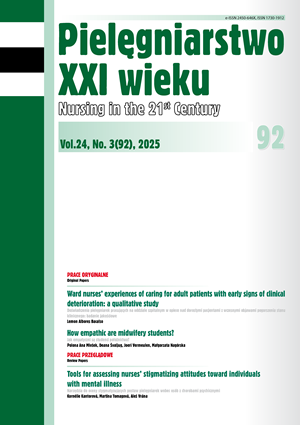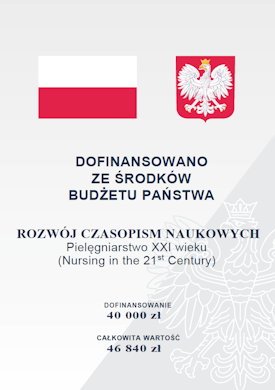What should be kept in mind when treating acne with oral contraceptives? Narrativereview
DOI:
https://doi.org/10.12923/pielxxiw-2025-0030Keywords:
contraceptives, treating acne, acne vulgaris, antiandrogensAbstract
Introduction. Acne vulgaris is a common dermatosis where hormonal factors, particularly androgens that increase sebum production, play a key role. This hormonal basis makes therapies with anti-androgenic effects, such as Combined Oral Contraceptives (COCs), a logical and effective treatment strategy. This review will describe the effectiveness and mechanisms of COCs in managing acne.
Aim. The aim of this review is to describe the effectiveness and effects of COC use in the treatment of acne, taking into account acne as a secondary lesion in the course of the below-mentioned conditions.
Material and methods. The medical literature was reviewed on October 19, 2024 using the PubMed, Scopus and Google Scholar browsers using the keywords: hormonal contraception, acne vulgaris. The time frame for searching the sample was from 2017 to the current date of the search. 15 articles were identified in the Google Scholar database, 12 in the PubMed database and 26 in the Scopus database.
Results. COCs can be effective in treating acne vulgaris due to their antiandrogenic properties. Androgens are believed to stimulate the growth of sebaceous glands and increase sebum production, contributing to acne formation. COCs are also used to manage other endocrine disorders associated with elevated androgen levels, such as hirsutism and polycystic ovary syndrome.
Conclusions. Acne vulgaris continues to be an important medical and social problem. This dermatosis affects not only young people, but also endocrinological patients or patients receiving permanent treatment. Knowledge of the mechanism of its formation and the role of hormones in its pathogenesis may allow it to determine the appropriate treatment algorithm.
References
1. Eichenfield DZ, Sprague J, Eichenfield LF. Management of acne vulgaris: a review. JAMA. 2021;326(20):2055-2067. https://doi.org/10.1001/jama.2021.17633
2. Santer M, Burden-Teh E, Ravenscroft J. Managing acne vulgaris: an update. Drug and Therapeutics Bulletin. 2024;62:6-10.
3. Kutlu Ö, Karadağ AS, Wollina U. Adult acne versus adolescent acne: A narrative review with a focus on epidemiology to treatment. Anais Brasileiros de Dermatologia. 2023;98(1):75-83. https://doi.org/10.1016/j.abd.2022.01.006
4. Samuels DV, Rosenthal R, Lin R, et al. Acne vulgaris and risk of depression and anxiety: A meta-analytic review. J. Am. Acad. Dermatol. 2020;83(2):532-541. https://doi.org/10.1016/j.jaad.2020.02.040
5. Tan AU, Schlosser BJ, Paller AS. A review of diagnosis and treatment of acne in adult female patients. Int. J. Womens Dermatol. 2017;4(2):56-71. https://doi.org/10.1016/j.ijwd.2017.10.006
6. Baldwin H, Tan J. Effects of diet on acne and its response to treatment. Am. J. Clin. Dermatol. 2021;22(1):55-65. https://doi.org/10.1007/s40257-020-00542-y. Erratum in: Am. J. Clin. Dermatol. 2020.
7. Rao A, Douglas SC, Hall JM. Endocrine disrupting chemicals, hormone receptors, and acne vulgaris: a connecting hypothesis. Cells. 2021;10(6):1439. https://doi.org/10.3390/cells10061439
8. DeGrazia TM, Rolader R, Thiboutot DM, et al. Eligibility criteria related to hormone therapy in acne clinical trials: a systematic review. J. Invest. Dermatol. 2021;141(1):189-191. https://doi.org/10.1016/j.jid.2020.05.086
9. Ju Q, Tao T, Hu T, et al. Sex hormones and acne. Clin. Dermatol. 2017;35(2):130-137. https://doi.org/10.1016/j.clindermatol.2016.10.004
10. Daghash R, Daghash A, Abu-Taha M. The clinical practice of acne treatment in polycystic ovary syndrome. 2021. https://doi.org/10.31838/ijpr/2021.13.03.156
11. Pfieffer ML. Polycystic ovary syndrome: An update. Nursing. 2019;49(8):34-40. https://doi.org/10.1097/01
12. Bosanac SS, Trivedi M, Clark AK, et al. Progestins and acne vulgaris: a review. Dermatol Online J. 2018;24(5):13030/qt6wm945xf
13. Shaw JC. Acne: effect of hormones on pathogenesis and management. Am. J. Clin. Dermatol. 2002;3(8):571-578. https://doi.org/10.2165/00128071-200203080-00007
14. Trivedi MK, Shinkai K, Murase JE. A Review of hormone-based therapies to treat adult acne vulgaris in women. Int. J. Womens Dermatol. 2017;3(1):44-52. https://doi.org/10.1016/j.ijwd.2017.02.018
15. Barbieri JS, Mitra N, Margolis DJ, et al. Influence of contraception class on incidence and severity of acne vulgaris. Obstet. Gynecol. 2020;135(6):1306-1312. https://doi.org/10.1097/AOG.0000000000003880
16. Barbieri JS, Shin DB, Wang S, et al. The clinical utility of laboratory monitoring during isotretinoin therapy for acne and changes to monitoring practices over time. J. Am. Acad. Dermatol. 2020;82(1):72-79. https://doi.org/10.1016/j.jaad.2019.06.025
17. Lammer EJ, Chen DT, Hoar RM, et al. Retinoic acid embryopathy. N. Engl. J. Med. 1985;313(14):837-841. https://doi.org/10.1056/NEJM198510033131401
18. Albogami Y, Sarayani A, Hincapie-Castillo JM, et al. Real-world fetal exposure to acne treatments in the united states: a retrospective analysis from 2006 to 2015. Drug. Saf. 2021;44(4):447-454. https://doi.org/10.1007/s40264-021-01053-3
19. Radi R, Gold S, Acosta JP, et al. Treating acne in transgender persons receiving testosterone: a practical guide. Am. J. Clin. Dermatol. 2022;23(2):219-229. https://doi.org/10.1007/s40257-021-00665-w
20. Borash J, Graber E. Acne treatment strategies 2023. Advances in Cosmetic Surgery. 2023;6(1):151-165. https://doi.org/10.1016/j.yacs.2023.01.004
21. Han JJ, Faletsky A, Barbieri JS, et al. New acne therapies and updates on use of spironolactone and isotretinoin: a narrative review. Dermatol. Ther (Heidelb). 2021;11(1):79-91. https://doi.org/10.1007/s13555-020-00481-w
22. Collins MK, Moreau JF, Opel D, et al. Compliance with pregnancy prevention measures during isotretinoin therapy. J. Am. Acad. Dermatol. 2014;70(1):55-59. https://doi.org/10.1016/j.jaad.2013.08.034
23. Nast A, Dreno B, Bettoli V, et al. European evidence-based (S3) guideline for the treatment of acne. Journal of the European Academy of Dermatology and Venereology. 2016;30(8): 1261-1268. https://doi.org/10.1111/jdv.13776
24. Cantrell W, Easley L, Squittieri K. Steroids used to treat acne vulgaris: a review of efficacy, safety, and clinical considerations. Journal of Drugs in Dermatology: JDD. 2024;23(6):404-409. https://doi.org/10.36849/jdd.7846. PMID: 38834219
25. Aaltonen P, Amory JK, Anderson RA, et al. 10th Summit Meeting consensus: recommendations for regulatory approval for hormonal male contraception. J. Androl. 2007;28(3):362-363. https://doi.org/10.2164/jandrol.106.002311
26. Abbe C, Roxby AC. Assessing safety in hormonal male contraception: a critical appraisal of adverse events reported in a male contraceptive trial. BMJ Sex Reprod. Health. 2020;46(2):139-146. https://doi.org/10.1136/bmjsrh-2018-200206
27. Behre HM, Zitzmann M, Anderson RA, et al. Efficacy and safety of an injectable combination hormonal contraceptive for men. J. Clin. Endocrinol. Metab. 2016;101:4779-4788. https://doi.org/10.1210/jc.2016-214
28. Bonnema RA, McNamara MC, Spencer AL. Contraception choices in women with underlying medical conditions. Am. Fam. Physician. 2010;82(6):621-628
29. Abbe CR, Page ST, Thirumalai A. Male contraception. Yale J. Biol. Med. 2020;93(4):603¬613.
30. Boos MD, Ryan ME, Milliren C, et al. Relationship between long-acting reversible contraception and acne in a cohort of adolescents and young adults. Pediatr. Dermatol. 2024;41(4):628-634. https://doi.org/10.1111/pde.15578
31. Oliveira ECF, Senra JC, Rocha ALL. The impact of using the levonorgestrel¬releasing intrauterine device on the incidence of acne in adolescents and young women. Eur. J. Contracept Reprod. Health Care. 2024;29(5):233-238. https://doi.org/10.1080/13625187.2024.2379363
32. Joham AE, Norman RJ, Stener-Victorin E, et al. Polycystic ovary syndrome. Lancet Diabetes Endocrinol. 2022;10(9):668-680. https://doi.org/10.1016/S2213-8587(22)00163-2. Erratum in: Lancet Diabetes Endocrinol. 2022;10(11):e11. https://doi.org/10.1016/S2213-8587(22)00281-9
33. Teede HJ, Misso ML, Costello MF, et al. International PCOS Network. Recommendations from the international evidence-based guideline for the assessment and management of polycystic ovary syndrome. Fertil. Steril. 2018;110(3):364-379. doi: 10.1016/j.fertnstert.2018.05.004
34. Buzney E, Sheu J, Buzney C, et al. Polycystic ovary syndrome: a review for dermatologists: Part II. Treatment. J. Am. Acad. Dermatol. 2014;71(5):859.e1-859. e15. https://doi.org/10.1016/j.jaad.2014.05.009
35. He C, Lin Z, Robb SW, et al. Serum Vitamin D levels and polycystic ovary syndrome: a systematic review and meta-analysis. Nutrients. 2015;7(6):4555-4577. https://doi.org/10.3390/nu7064555
36. Park JA, Carter EE, Larson AR. Risk factors for acne development in the first 2 years after initiating masculinizing testosterone therapy among transgender men. J. Am. Acad. Dermatol. 2019;81(2):617-618. https://doi.org/10.1016/j.jaad.2018.12.040
37. Wierckx K, Van de Peer F, Verhaeghe E, et al. Short- and long-term clinical skin effects of testosterone treatment in trans men. J. Sex Med. 2014;11(1):222-229. https://doi.org/10.1111/jsm.12366
38. Yeung H, Ragmanauskaite L, Zhang Q, et al. Prevalence of moderate to severe acne in transgender adults: A cross-sectional survey. J. Am. Acad. Dermatol. 2020;83(5):1450-1452. https://doi.org/10.1016/j.jaad.2020.02.053
39. Rocha M, Barnes F, Calderón J, et al. Acne treatment challenges – Recommendations of Latin American expert consensus. Anais Brasileiros de Dermatologia. 2024;99(3):414-424. https://doi.org/10.1016/j.abd.2023.09.001
40. Motosko CC, Zakhem GA, Pomeranz MK, et al. Acne: a side-effect of masculinizing hormonal therapy in transgender patients. Br. J. Dermatol. 2019;180(1):26-30. https://doi.org/10.1111/bjd.17083
41. Ingram JR, Woo PN, Chua SL, et al. Interventions for hidradenitis suppurativa. Cochrane Database Syst. Rev. 2015;2015(10):CD010081. https://doi.org/10.1002/14651858.CD010081.pub2
42. Diamanti-Kandarakis E. Current aspects of antiandrogen therapy in women. Curr. Pharm. Des. 1999;5(9):707-723.
43. Penning-van Beest FJA, Bezemer ID, Smits E, et al. Reduction in use of cyproterone/ethinylestradiol (Diane-35 and generics) after risk minimization measures in the Netherlands, UK and Italy. Contraception. 2020;102(4):243-245. https://doi.org/10.1016/j.contraception.2020.05.010
44. Lidegaard Ø, Løkkegaard E, Svendsen AL, et al. Hormonal contraception and risk of venous thromboembolism: national follow-up study. BMJ. 2009;339:b2890. https://doi.org/10.1136/bmj.b2890
45. European Medicines Agency. Assessment report: Cyproterone acetate/ ethinylestradiol (2 mg/0.035 mg) containing medicinal products. 2013.
46. Lidegaard Ø, Nielsen LH, Skovlund CW, et al. Risk of venous thromboembolism from use of oral contraceptives containing different progestogens and oestrogen doses: Danish cohort study, 2001-9. BMJ. 2011;343:d6423. https://doi.org/10.1136/bmj.d6423
47. Bezemer ID, Smits E, Penning-van Beest FJA, et al. Thrombotic risk minimization for Diane-35 and generics. Pharmacoepidemiol Drug Saf. 2017;26(11):1411-1417. https://doi.org/10.1002/pds.4319
48. Lapi F, Simonetti M, Cricelli I, et al. Prescription appropriateness of cyproterone acetate/ethinylestradiol in primary care: a population-based study in Italy. Clin. Drug Investig. 2017;37(8):755-762. https://doi.org/10.1007/s40261-017-0529-9
49. Gourbil M, Grandvuillemin A, Beyens MN, et al. French Network of Regional Pharmacovigilance Centres. Thromboembolic events in women exposed to hormonal contraception or cyproterone acetate in 2012: a cross-sectional observational study in 30 French public hospitals. Drug Saf. 2014;37(4):269-282. https://doi.org/10.1007/s40264-014-0149-8
50. Acne vulgaris. Nat. Rev. Dis. Primers. 2015;1:15033. https://doi.org/10.1038/nrdp.2015.33
51. Kircik LH. Advances in the understanding of the pathogenesis of inflammatory acne. J. Drugs Dermatol. 2016;15(1 Suppl 1):7-10.
52. Moradi Tuchayi S, Makrantonaki E, Ganceviciene R, et al. Acne vulgaris. Nat Rev Dis Primers. 2015;1:15029. https://doi.org/10.1038/nrdp.2015.29
53. Knutsen-Larson S, Dawson AL, Dunnick CA, et al. Acne vulgaris: pathogenesis, treatment, and needs assessment. Dermatol. Clin. 2012;30(1):99-106. https://doi.org/10.1016/j.det.2011.09.001
54. Krasowska D. Etiopatogeneza i obraz kliniczny trądziku pospolitego. Dermatologia Estetyczna. 2006;2:67-71.
55. Louw-du Toit R, Perkins MS, Hapgood JP, et al. Comparing the androgenic and estrogenic properties of progestins used in contraception and hormone therapy. Biochem. Biophys. Res. Commun. 2017;491(1):140-146. https://doi.org/10.1016/j.bbrc.2017.07.063
56. Williams HC, Dellavalle RP, Garner S. Acne vulgaris. Lancet. 2012;379(9813):361-372. https://doi.org/10.1016/S0140-6736(11)60321-8 Erratum in: Lancet. 2012;379(9813):314.
57. Grandi G, Guariglia G, Facchinetti F. The role of combined oral contraceptives containing norgestimate for acne vulgaris treatment: a review. Eur. J. Contracept. Reprod. Health Care. 2023;28(3):184-191. https://doi.org/10.1080/13625187.2023.2197539
Downloads
Published
Issue
Section
License
Copyright (c) 2025 Pola Bakalczuk, Małgorzata Satora, Arkadiusz Grunwald, Krzysztof Kułak, Kinga Brzuszkiewicz, Grzegorz Bakalczuk (Autor)

This work is licensed under a Creative Commons Attribution 4.0 International License.




